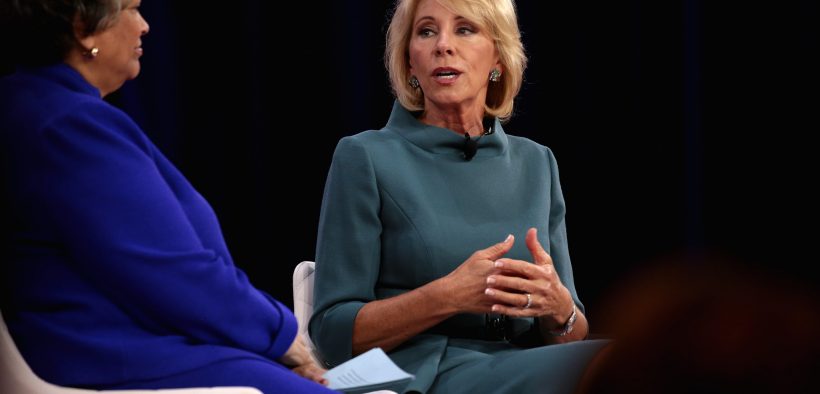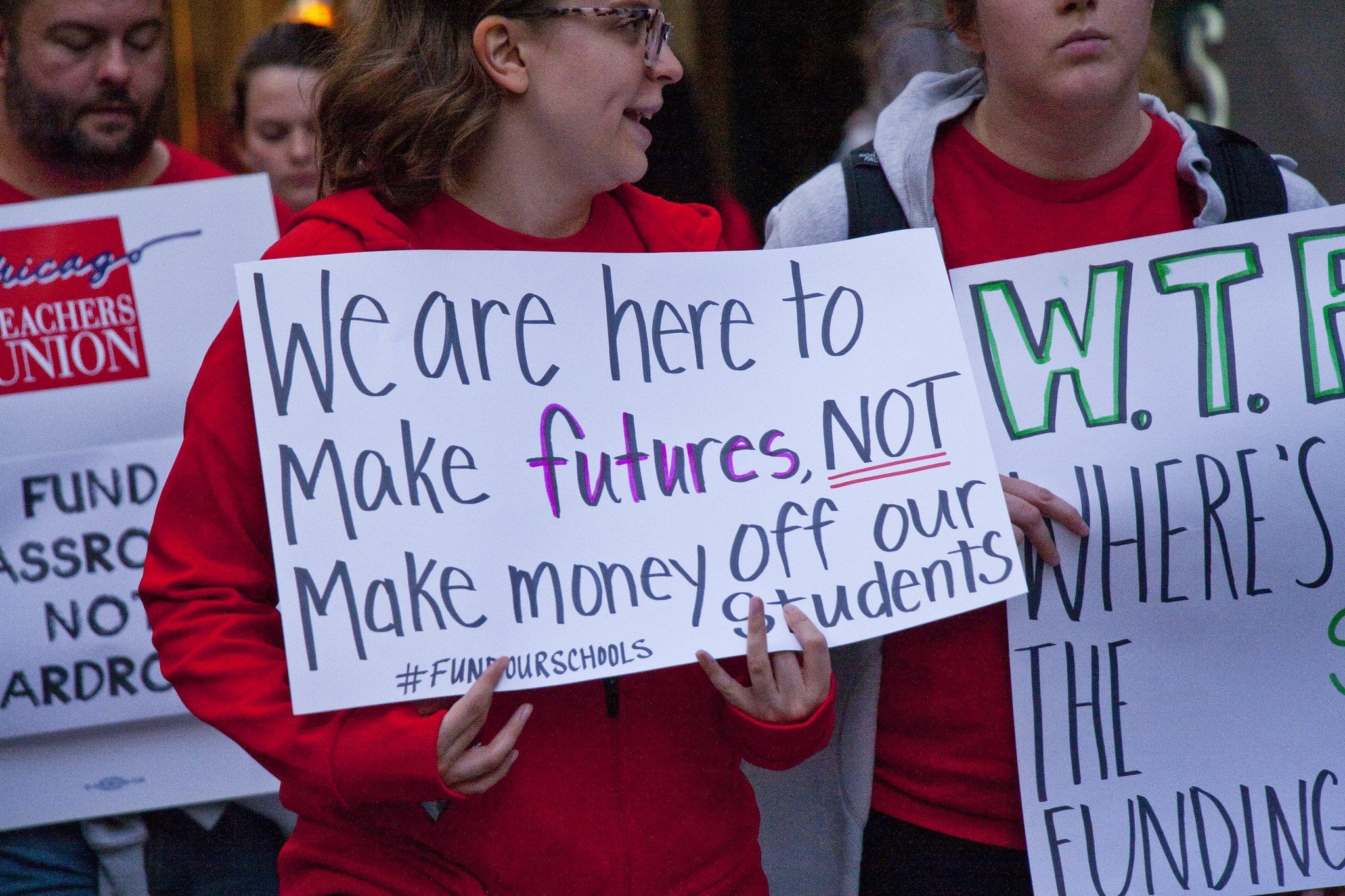How the ‘School Choice’ Movement Has its Roots in Racism

“We have experimented educationally on children who are poor, who are of color, who go to underfunded schools. We come up with ways of teaching them that are experiments and have absolutely no kind of basis in research.”
Charter schools and the “school choice” movement have become a major part of the fabric of the American education system in recent years, but what are the origins of these institutions and this educational ideology?
In America, there are about 3 million students attending more than 7,000 charter schools around the country, and with the current prevailing political and economic tendencies in the United States, it seems highly likely that this number is only going to continue to grow.
Education and the Trump Administration
During his 2016 campaign, Donald Trump promised that if elected, he would be the “nation’s biggest cheerleader for school choice,” and has already made many bold moves on this front, including appointing school choice advocate Betsy DeVos as his Secretary of Education. In May 2017, DeVos was quoted as saying that the goal of Trump’s administration is to enact “the most ambitious expansion of education choice in our nation’s history.”
DeVos has been one of the most vocal champions of the “school choice” movement, pushing all sorts of legislation on the topic, including most recently a federal tax credit that would provide 5 billion dollars in federal money to fund private school scholarships. The plan has faced opposition from both conservatives and liberals who see it as a voucher program by a different name and a way to siphon public funds away from struggling public schools.
Growth of Charter Schools

Chicago Teachers Union Members and Allies Picket Outside Chicago Public Schools Headquarters Downtown Chicago Illinois 9-26-18. (Photo: Charles Edward Miller)
Many cities around the country have begun to favor charter schools over traditional public schools, and most of the cities with high rates of enrollment in charter schools are financially strapped areas that are dealing with economic turmoil and a fractured public education system.
According to the Key Facts About Charter Schools publication, in Flint, 55 percent of students in the district attend charter schools, and in Detroit, 53 percent of students are educated at charter institutions. New Orleans has the highest number of students enrolled in charter schools, at a whopping 93 percent.
So, what are the benefits of charter schools? Shaelyn Macedonio, who manages media relations at the National Alliance for Public Charter Schools, told Citizen Truth that “Charter schools give parents more public-school choices by providing a local high-quality public-school option. Each charter school has a unique charter that can foster a specific school culture, curriculum or focus that may better meet a child’s needs than their local zoned district school.”
However, the origins of the “school choice” movement that led to the creation of charter schools are somewhat troubling, and many experts are concerned that an educational model based on charter schools and vouchers is not good for American students.
The Racist Roots of School Vouchers, Benchmarking and ‘School Choice’
The southern states have more charter schools and school choice programs than any other region of the country, a fact which stems from the area’s past struggles with discrimination and segregation. While desegregation was occurring in public schools from 1954 to 1965, hundreds of laws were passed by southern states in an attempt to keep the practices of segregation in place, even if federal law officially prohibited that these practices be codified in laws. Many of the laws were based around the principle of diverting public funds to finance private schools that would remain segregated.
Laws such as Alabama’s pupil placement bill provided strict criteria for deciding which public schools students would attend. Standardized tests were used to test students’ intellectual capacity and level of knowledge, and factors such as students’ home lives and neighborhoods were also taken into account. This was the beginning of using benchmarks such as standardized tests to relegate certain students to worse schools and zoning school districts in order to disenfranchise lower-income communities.
In 1954, Louisiana passed comprehensive voucher legislation due to the recommendations of the Rainach Committee, headed by state senator William M. Rainach. This legislation initiated a voucher program that white students could use to attend segregated private schools while also giving public schools that wished to remain segregated the option to reestablish themselves as “private education cooperatives.”
As late as April 1956, nearly two years after the Brown v. Board of Education decision, the Pearsall Committee in North Carolina announced its intention to “preserve a segregated school system” and attempted to find clever ways to do this without violating new federal regulations.
The Pearsall Committee’s report included language such as the claim that the Supreme Court’s ruling in Brown v. Board of Education couldn’t prevent school districts from placing students based on “natural racial preference and the administrative determination of what is best for the child.” It also claimed that the Court’s decision could not legally require “mixing of the races.”
In Virginia, reports from the pro-segregation Gray Commission make frequent mention of “freedom of choice” regarding school placement. This began the trajectory that is being continued today with the “school choice” movement.
In January of 1963, then governor of South Carolina Donald Russell unveiled the state’s new voucher program. He claimed that this would foster competition between private and public schools and therefore “stimulate progress in public education.” This rhetoric is echoed in the arguments of school choice advocates like Betsy DeVos to this day.
Federal Courts recognized these ploys as thinly disguised attempts to keep de facto segregation in place, and as a result by the mid-1960s, most state voucher programs had been ruled to be unconstitutional. Despite the racist history of voucher programs and the school choice movement, many conservative education reformers claim that these changes will actually improve educational opportunities for minority students.
Another early advocate of “school choice” and voucher programs was University of Chicago economist Milton Friedman, infamous for his extreme libertarian economic principles and support of the murderous Pinochet dictatorship in Chile. His faith in voucher programs and private, for-profit educational institutions stemmed from one of his ideas that is often parroted by modern-day conservative politicians, the belief that “competitive private enterprise is likely to be far more efficient in meeting consumer demands than nationalized enterprises.”
Problems in Oklahoma
Oklahoma has a massive amount of charter schools, and as a result, is facing an equally large problem due to the shortfalls of these educational institutions. One of the biggest charter organizations in Oklahoma is Epic Charter Schools, an online-based learning leviathan that is currently under investigation by the Oklahoma State Bureau of Investigation and federal law enforcement authorities.
Former teachers who worked at schools under the Epic umbrella claimed “teacher bonuses were dangled like a carrot” in order to incentivize withdrawing underperforming students, using late student enrollment and employing other tactics in order to manipulate test results and bolster the schools’ standing. Former teachers at Epic Charter Schools have sued the company, claiming that they were fired as a result of speaking up against these practices.
The situation with Epic Charter Schools highlights the murky and convoluted regulations surrounding charter schools, online schools and other alternative education institutions. Following Epic’s standard policy, an online student can be automatically withdrawn if less than 31 online assignments are completed over a nine-week period.
Public schools are subject to more regulation and have more stringent procedures regarding student withdrawal and expulsion. But current Oklahoma state laws allow virtual or online schools a massive amount of leeway with regards to documenting attendance, which allows these institutions to utilize different strategies to make these statistics fit their goals.
Since Epic’s policy centers on the amount of assignments that students complete, teachers are instructed to overload students not expected to pass state standardized tests with extra assignments in order to make it impossible for them to keep up with the course load.
Angie Wren, a former teacher at Epic Charter Schools, told Oklahoma Watch, “My principal would instruct me to give additional remediation assignments and mandatory online homework-help sessions that made it almost impossible for the kids to keep up with. When students couldn’t keep up with the extra things assigned, my principal began pressuring me to withdraw them for truancy.”
Billionaires Funding Charter School Programs

Bill and Melinda Gates during their visit to the Oslo Opera House in June 2009. The Bill and Melinda Gates Foundation is one of the biggest donors and supporters of charter schools across the country. (Photo: Kjetil Ree)
Noliwe Rooks, Ph.D., is a professor of American and Africana studies at Cornell University who has written extensively about educational inequality, most recently in her book Cutting School: Privatization, Segregation, and the End of Public Education. She began to wonder why so many billionaires were interested in funding charter schools and other similar programs in poor and rural communities in the United States and developed a theory that she calls “segrenomics.”
This concept is based on the fact that many “innovations” in education, such as charter schools and online classrooms, have never really been accurately tested to determine their efficacy. Rooks explains, “We have experimented educationally on children who are poor, who are of color, who go to underfunded schools. We come up with ways of teaching them that are experiments and have absolutely no kind of basis in research.”
However, when one remembers all the billionaires pushing for charter school expansion and the huge amount of money these corporations are making as a result of these experiments, the situation seems even more sinister. As Rooks points out, “The underfunding and the experimentation are actually very lucrative for a handful of companies that make hundreds of millions of dollars a year profiting from the undereducation and experimentation.”
In a speech she gave last summer, DeVos told listeners, “My work in education over 30 years has revolved around time invested on the outside,” as The Washington Post reported. “Outside the Department of Education. Outside the system. Outside Washington. I think that’s a good thing. Don’t you?”
This is part of the larger trend of some politicians promoting lack of experience and knowledge as positive attributes, but also highlights the experiments in education that are using poor, underprivileged students as guinea pigs.
Voucher Programs and Charter Schools Defund Public Education
Charter schools are often for-profit institutions and operate with little to no regulations and oversight. Lisa Guisbond, Executive director of Citizens for Public Schools, a Massachusetts-based public education advocacy organization, told Citizen Truth how charter schools threaten public education.
“Since charter schools take public funds but are managed by private boards, right away, they go against two of our goals for public education: keeping public funds in public, democratically accountable, inclusive schools and maintaining adequate and equitable funding. Public schools are already being squeezed by a lack of investment of state and local resources. Charter schools worsen the situation by diverting public funding from existing public schools.”
Charter schools and other educational alternatives that are touted as giving parents and students more freedom and options often have a devastating effect on the public-school districts where these programs are put into place.
In a study completed by the watchdog group In the Public Interest investigating the West Contra Public School District in California, investigators found that the school district loses $27.9 million every year due to money being diverted to fund charter schools operating within the boundaries of the school district. As a result of this staggering loss of financial support, the school has been forced to reduce spending on important programs like tutoring services and ESL teachers.
When asked what can be done to fix the problem, Guisbond told Citizen Truth that adequate funding is paramount.
“U.S. public schools that have adequate and equitable resources tend to do a great job of educating their students, so job one is to make sure we are investing enough resources at the federal, state and local level to allow schools to get the job done. We need to tackle the re-segregation and racial isolation that afflicts so many of our student and communities. And we need to invest in our prospective and current teachers, so they can afford to get the training they need and get compensated enough so they don’t need to work two or three jobs to get by,“ Guisbond said.
The history of education in the United States is twisted and marred by a history of segregation, inequality and lack of opportunities. The way that children are educated in America is going to continue to change drastically, and if current trends prevail, the institution of public education is threatened at its very core.
*Editor’s Note: After the publishing of this article we received a letter to the editor from the National Alliance for Public Charter Schools. We have included their response below:
Letter to the Editor
Will Bacha’s recent piece, “How the School Choice Movement Has its Roots in Racism”, makes a declaration over the origin of school choice that could not be further from the truth. Charter schools were created to serve public school students – particularly those who have been systemically failed by their public schools for generations. Most of these students are low-income students and students of color. By law, all charter schools are public schools, so to say that they divert public dollars from public schools is factually incorrect. Any responsible adult would agree that regardless of a school type, there is no room for failing or non-transparent schools in public education. Charter schools are held to high accountability standards by their authorizers, boards and parents and are they are bringing kids academic success. According to a 2015 study by Stanford University’s CREDO, in urban charter schools, low-income Hispanic students gained 48 additional days in math and 25 additional days in reading per year. In addition, low income Black students gained 59 additional days in math and 44 additional days in reading per year. In many places in America, charter schools are a high-quality public-school solution for families whose school needs continue to be unmet. Charter schools empower Black and Hispanic families to provide their children with an excellent education regardless of their zip code. Anyone that wants to stand in the way of that reality is out of touch with what our families want.
Amy Wilkins is the senior vice president of advocacy at the National Alliance for Public Charter Schools. Prior to her time at the National Alliance Amy spent almost two decades at Education Trust. Amy is the daughter of a civil rights leader and the niece of another.














Where in the world does “multiculturalism” actually work?
Again we c the arms of inequality reach out to the most needy. We forget as Americans that the original sin of America is RACISM. It is ingrained in our culture and lives . But when there is dissenting points of view we have the haves and deniers screaming ? foul . We as a nation need to go to confession and repent for our misdeeds and blatant lack of respect and include of all people into our society. Without the covert action of putting money , the real reason to educate the poor.
Great Job!